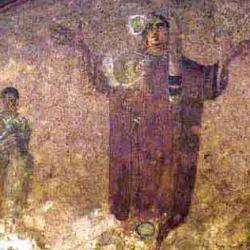Amalar of Metz’s On the Liturgy, recently published in a handsome two-volume Latin-English edition in the Dumbarton Oaks Medieval Library, represents the kind of “mysteriological” piety against which modern liturgical scholars like Bouyer and Schmemann fulminated. For Amalar, every moment and movement of the liturgy symbolizes some event of biblical history. Liturgy becomes re-enactment, rather than a journey to the kingdom coming.
Bouyer, Schmemann and the others are right. But what Amalar lacks in sophistication, he makes up in good old Carolingian charm. Who can disparage someone who writes, of the Maundy Thursday foot-washing, “Shoes are made from dead animals. The dead animal is Adam, from whom we have derived our death. Let us see if our mind has, in some fashion, been shot with his death. . . . When the mind busies itself with [worldly matters], it is shod in the skins of a dead animal. As we enter holy places where the Lord and his angel dwell, let us cast off these shoes and contemplate the life of angels” (1.135).
Or (quoting Bede), “the table of the tabernacle has four feet, because we are accustomed to accept the words of the heavenly oracle according to their historical and allegorical and tropological (that is, moral) and anagogical sense” (1.199). Of course, that must be just the reason the table had four feet.
Sometimes Amalar is more than charming, as when he explains the sign of the cross, made with oil, placed on the forehead of a neophyte: “This cross is made of chrism, which is made of oil and balsam. Such liquid manifests the works of our guest. In our mind it plants charity, which is signified through the oil with its leafy foliage, and it breathes out of us the odor of good renown, just as good odor emanates from the balsam. . . . The cross is nowhere better fixed than in the place were the high priest fixed the golden plate, on which the ineffable name of God had been carved” (1.273).
Initiation confers a priesthood, involving charity and the aroma of Christ; a priesthood signified by a cross where the name of God was once placed; a priesthood by chrism because priesthood shared with the Christ. A bountiful theology of initiation, and of lay priesthood is embedded here. Even mysteriological liturgists have somewhat to teach us.















